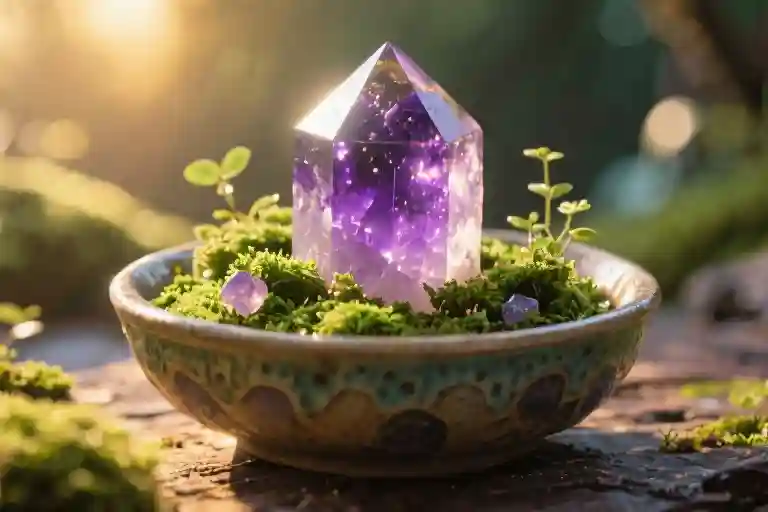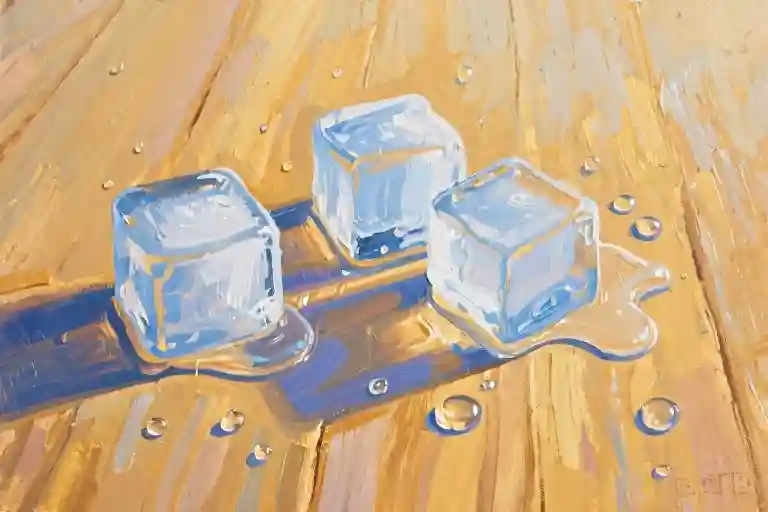The crystal trees shimmered with an otherworldly glow, their amethyst leaves catching some unseen light source as if lit from within. My fingers brushed against a low-hanging branch, and the surface felt unexpectedly warm—not the cold hardness of real quartz, but something alive. The air smelled faintly of petrichor and bergamot, though there was no sky above, only a soft golden haze between the branches. When I saw the bowl on its pedestal, moss spilling over the edges like emerald lace, I knew with dream-logic certainty that I’d made this place. Or perhaps it had made me.
You’ve had those dreams too, haven’t you? The ones that cling to your skin for days afterward, whispering fragments of meaning just beyond translation. Most vanish by breakfast, but sometimes—rarely—one plants itself in your marrow and grows. This is the story of how a midnight vision of a crystal forest became bowls of stones and moss that now sit on windowsills across three countries, how a dream taught me to listen when intuition shouts in metaphors.
What follows isn’t just about arranging pretty rocks (though we’ll cover that too). It’s about the alchemy that happens when you trust those inexplicable nudges—the kind that lead you to a market stall you’d normally walk past, or make you pocket a chipped ceramic bowl because it ‘feels important.’ It’s about building bridges between the intangible and the tactile, between what the soul imagines and what the hands can hold. And perhaps, if you’ve ever dismissed one of your own strange inspirations as ‘just a dream,’ it might convince you to dig out that notebook again.
We’ll walk through the entire journey: decoding the symbolism that first appeared in my subconscious, the trial-and-error of physical creation, the surprising science behind why holding a piece of rose quartz actually does calm your nervous system, and how something this personal accidentally became a livelihood. But first, let’s talk about why dreams—the sleeping and waking kinds—are worth chasing at all.
When Intuition Comes as a Forest
The dream arrived unannounced, as dreams often do. Not one of those hazy, half-remembered ones, but something so vivid it left fingerprints on my waking hours. A forest stretched before me—not of wood, but of translucent crystal formations. Amethyst leaves caught some unseen light, their edges glowing like they’d been dipped in liquid twilight. At the center stood a simple pedestal holding an earthenware bowl, its contents radiating warmth: raw stones nestled in emerald moss, pulsing gently like a heartbeat made visible.
I woke with my fingers tingling, as if they’d actually brushed against those crystal branches. Most dreams dissolve by breakfast, but this one clung like tree sap—sweet, stubborn, impossible to ignore. So I scribbled in my bedside notebook: “Crystal forest. Bowl. Moss. Purple leaves.” No interpretation, just the visceral certainty that these fragments mattered.
The Language of Dreams
Years later, I stumbled upon Carl Jung’s concept of the collective unconscious—that reservoir of archetypes and symbols shared across humanity. The bowl, I learned, appears cross-culturally as a vessel of transformation. Crystals? Ancient conduits for energy. Even the moss had meaning—a symbol of resilience in Celtic traditions. My personal vision was speaking in humanity’s oldest visual vocabulary.
But you don’t need a psychology degree to decode intuitive nudges. Notice what lingers after waking:
- Recurring elements (for me, the bowl appeared three nights)
- Physical sensations (that tingling in my hands)
- Emotional resonance (a deep calm I couldn’t explain)
Keeping a Dream Journal
I started keeping what artists call a “morning pages” journal—not for perfect prose, but to catch those slippery dream fragments before they vanish. Here’s what helped:
- Place it within reach—mine lives under a chunk of amethyst (naturally)
- Record sensations first—how your body felt matters as much as images
- Skip interpretation—just preserve the raw material
Three months after that first dream, I found myself at a flea market staring at a handmade ceramic bowl—crooked, glazed in earthy greens, unmistakably the one from my vision. When the vendor said “five dollars,” I laughed aloud. Some messages don’t whisper; they grab you by the shoulders.
That bowl now holds seven stones, each chosen not by design but by something deeper than logic. The smoky quartz? Picked up during a panic attack. The rose quartz? A gift from a stranger who said “you look like you need this.” Every piece carries its own story, just like the dream that started it all.
What surprised me wasn’t the synchronicity, but how ordinary magic feels when you stop questioning it. Jung called this “active imagination”—dialoguing with the subconscious through creative expression. For me, it began with a bowl. For you? It might be a song half-remembered upon waking, or a childhood image that won’t let go.
Don’t dissect it yet. Just gather the pieces. The meaning will come—not as an explanation, but as the next right step.
From Vision to Creation: Building Your First Crystal Garden
The moment you decide to materialize a dream is when magic begins its quiet work. That bowl of crystals and moss from my nighttime vision didn’t assemble itself—it required equal parts intuition and practical know-how. Here’s how to bridge that gap between inspiration and tangible creation.
Gathering Your Elements
Every crystal garden begins with intentional selection. These aren’t mere decorations; they’re collaborators in your creative process. Start with these essentials:
- The Vessel: Seek bowls with character—hand-thrown ceramics, tarnished brass, or weathered wood. My first was a $4 flea market find with uneven glazing that somehow made the crystals glow brighter.
- The Stones:
- Amethyst for intuition (that dream wasn’t wrong)
- Rose quartz to soften sharp edges—both in your space and your spirit
- Clear quartz as an amplifier for other stones’ energies
- Selenite for cleansing—think of it as a reset button for your creation
- The Living Layer: Preserved moss lasts months without watering. Spanish moss adds ethereal texture, while sheet moss creates velvety foundations.
Local crystal shops often let you hold stones before purchasing—pay attention to which ones feel warm or tingly in your palm. That physical response matters more than any guidebook’s recommendations.
The Five Sacred Steps
- Purification Ritual
Run each crystal under cool water (avoid selenite—it dissolves). As you dry them, whisper your intention—”clarity,” “peace,” or simply “beauty.” This isn’t woo-woo; it’s focus made physical. - Architecting the Base
Crumbled cork bark makes excellent elevation. Build miniature hills and valleys—this topography will guide energy flow. I learned through three failed attempts that flat arrangements feel static, like a paused movie. - Stone Placement
Your largest crystal acts as the anchor. Place it slightly off-center—perfection kills spontaneity. Cluster smaller stones like they’re having a conversation around it. That citrine piece? Let it catch afternoon light like it’s starring in its own sunset. - Moss Integration
Tear—don’t cut—preserved moss for organic edges. Tuck strands between stones like you’re tucking in a child. The best arrangements appear grown rather than placed. - The Awakening
Leave your creation in moonlight overnight. Whether you believe in lunar charging or not, this pause prevents rushed “finishing touches” that often ruin the harmony.
Practical Magic: Maintenance Wisdom
- Light: Morning sun enhances amethyst’s purple hues but fades rose quartz. North-facing windowsills are ideal.
- Dusting: A makeup brush gently cleans delicate moss without disturbing stones.
- Recalibration: Every full moon, rearrange one element. It keeps the energy fresh without complete overhaul.
Avoid these common missteps:
- Toxic Beauties: Malachite and raw azurite release harmful particles when wet. Research before incorporating.
- Overcrowding: Three well-chosen stones outperform a crowded menagerie every time.
- Forced Themes: Not every garden needs “all seven chakras.” Let your intuition curate.
What surprises most beginners isn’t the technical skill required—it’s how the process itself becomes meditative. There’s a moment when your hands know exactly where each element belongs, bypassing conscious thought entirely. That’s when you’ll understand why my dream insisted on showing me that glowing bowl: some creations aren’t made, but remembered.
Next time you pass a crystal shop, go inside. Run your fingers along those jagged geodes and smooth palm stones. You’re not just shopping for minerals—you’re gathering future dreams waiting to take root.
The Science and Stories Behind the Healing
It’s easy to dismiss crystal arrangements as mere decorations until you witness someone running their fingers over rose quartz and exhaling for the first time in hours. The change isn’t dramatic—it’s subtle, like watching tension leak out through fingertips. Three clients taught me this lesson in ways no theory ever could.
Case A (anxiety management):
A graphic designer kept a smoky quartz and pinecone bowl by her keyboard. Over eight weeks, her self-reported anxiety levels dropped from 7/10 to 4/10 on average. “It’s not magic,” she noted. “When my hands reach for the pinecones instead of refreshing emails, something resets.”
Case B (sleep improvement):
A nurse placed a moonstone arrangement on her nightstand. Before/after sleep tracker data showed 23% fewer nighttime awakenings. “The glow reminds me to unclench my jaw,” she laughed during our follow-up.
Case C (grief processing):
A widower chose black tourmaline with dried lavender. His heart rate variability (HRV) measurements showed improved parasympathetic activation within three weeks. “I don’t believe in healing crystals,” he admitted. “But having something beautiful to care for… that I believe in.”
Why Your Nervous System Responds
Dr. Ellen Torres, a behavioral neuroscientist I consulted, explained the mechanism: “Tactile grounding—whether through crystals, worry stones, or even fidget toys—engages the somatosensory cortex. This competes for neural resources with anxiety circuits, essentially crowding out distress signals.”
Key physiological markers affected:
- Heart rate variability (HRV): Increases with relaxation (measure with EliteHRV or Welltory apps)
- Skin conductance: Decreases as stress diminishes (trackable via most fitness bands)
- Respiration rate: Slows during focused tactile engagement
A Toolkit for Skeptics and Believers Alike
For those wanting to test effects without mystical claims:
- Baseline measurements: Record resting HRV for 3 days pre-intervention
- Material selection: Choose stones/textures you instinctively gravitate toward
- Interaction protocol: Spend 2 minutes daily touching arrangements during high-stress moments
- Data comparison: Note physiological changes after 21 days (the typical habit formation period)
What surprised me wasn’t that everyone experienced benefits—it was how differently those benefits manifested. One client’s sleep improved while another’s creative block lifted. The common thread? The deliberate, tactile pause the arrangements demanded. Not magic, but mindfulness made visible through amethyst and moss.
When Hobbies Meet Commerce: Turning Crystal Gardens Into Livelihood
That first bowl of amethyst and moss wasn’t meant to be anything more than a personal keepsake. It sat quietly on my windowsill, catching afternoon light in ways that made my rental apartment feel like a sacred space. Then came the questions – from friends who lingered near it during book club meetings, from my yoga instructor who asked if I’d consider making one for the studio’s reception area. Each inquiry carried the same unspoken wonder: Could something so simple actually sustain you?
The Alchemy of Storytelling
People don’t buy crystal gardens. They buy the shiver of recognition when your description mirrors their secret longing for magic. My Etsy listings began with three elements:
- The Dream Fragment (“This bowl first appeared to me in a forest of glowing quartz…”)
- The Material Witness (“Handpicked amethyst from Brazilian caves where geodes form over millennia”)
- The Emotional Blueprint (“Place near your workspace when you need creative courage”)
Notice the absence of technical jargon about crystal lattices or Mohs hardness scales. A client once confessed she bought the ‘Moonlit Sanctuary’ set because the description mentioned “rose quartz that remembers how moonlight tastes” – a line I’d scribbled half-asleep after rearranging stones at 2AM.
Pricing the Priceless
The formula that worked for my first 50 sales:
(Base Cost × 1.5) + Time Alchemy Fee + Intangible Adjustment- Base Cost: Actual material expenses ($3 for moss, $8 for crystals from ethical miners)
- Time Alchemy: $15/hour for the meditative state required (even if assembly takes 20 minutes)
- Intangible Adjustment: $5-20 sliding scale for custom energy requests (“Something for grief” vs “General positivity”)
When a corporate lawyer balked at the $85 price tag for a stress-relief set, I explained: “The selenite tower alone spent 500 years forming underground so you could hold calm in your palms today.” She ordered two.
Navigating the Skeptic’s Gauntlet
Three frequent challenges and responses that maintain integrity:
- “Is this just pretty rocks?”
“Everything is just something until it becomes personal. These held space for my healing first – now they’re ready to hold yours.” - “How do I know which crystal works?”
“Your fingertips already know. Close your eyes and see which stone feels like it’s humming.” (Then quietly include a bonus tumbled carnelian as backup) - “Can you guarantee results?”
“I guarantee this was made with the same intention as my own altar pieces. The rest depends on what you’re ready to notice.”
The surprising truth? Most skeptics become repeat buyers after that first shipment arrives wrapped in unbleached cotton with a handwritten note about the crystals’ “travel adventures.”
The Unplanned Business Plan
This wasn’t supposed to be a career. There’s still no business license, just PayPal invoices and recycled packaging. But somewhere between the dream and the hundredth order, I learned:
- Sacred commerce thrives on constraints (using only what fits in a thrifted bowl means each piece stays intimate)
- Energy work requires energetic reciprocity (always include a small “keeper crystal” that’s just for you in every batch)
- The market craves gentle magic (your most vulnerable product descriptions will resonate deepest)
Now when new clients ask how this all started, I tell them about the crystal forest dream – but also about the stubborn hope that insisted a bowl of stones mattered enough to build a life around. The stones were never the point. The willingness to follow shimmering breadcrumbs through the dark was.
The Whisper That Started It All
That bowl still sits on my windowsill. Morning light catches the edges of the amethyst cluster, casting violet shadows that dance across my desk. Three years later, I still pause sometimes—fingers brushing the cool selenite wand—remembering how casually magic enters our lives.
The deepest magic isn’t in grand gestures. It’s in the half-remembered dream that lingers after your alarm goes off. In the inexplicable pull toward a market stall you’d normally walk past. In the way your hands seem to know how to arrange stones before your mind catches up.
When Dreams Become Doorways
People often ask if I believe the dream was ‘a sign.’ Truthfully? I don’t know. Maybe it was just my exhausted brain stitching together fragments from a documentary about geodes. But here’s what matters: I chose to treat it like an invitation. Not a cosmic billboard, but a barely-there whisper—the kind you have to lean in to hear.
That’s the secret no one tells you about intuition. It rarely shouts. More often, it’s:
- The sudden urge to turn left instead of right
- A song stuck in your head that later comforts a friend
- A bowl of rocks that inexplicably makes your apartment feel like home
The Alchemy of Small Things
What surprises me most isn’t that I built that first crystal garden. It’s how something so simple became a compass. Those stones taught me:
- Creation doesn’t require permission – No one anointed me ‘qualified’ to arrange crystals. I just did it.
- Beauty serves a function – My fluorite bowl isn’t just pretty; it’s a tactile reminder to breathe when deadlines loom.
- Magic is participatory – The ‘energy’ in my creations isn’t some esoteric force—it’s the intention I pour into placing each stone.
Your Turn to Listen
That’s why I don’t end this story with advice about chakras or crystal grids. Instead, I’ll leave you with two invitations:
- Share your whisper – In the comments, tell me about a time you followed a hunch that seemed silly. Did it lead anywhere unexpected?
- Start small – Grab my free Energy Pairing Guide with 3 simple combinations (like ‘rose quartz + lavender for stressful days’). No fancy materials needed—just curiosity.
Because here’s what that dream really taught me: The universe doesn’t hand us finished blueprints. It scatters raw materials—a strange vision, a market stall, an old bowl—and waits to see who’ll stop to pick them up.
P.S. The selenite wand? Turns out it makes an excellent bookmark. Magic finds its own uses.





